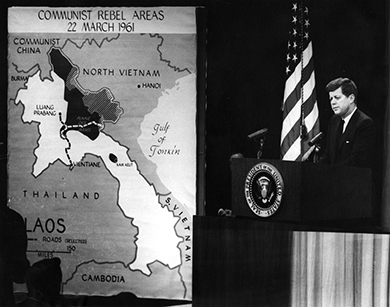| << Chapter < Page | Chapter >> Page > |
Cuba was not the only arena in which the United States sought to contain the advance of Communism. In Indochina, nationalist independence movements, most notably Vietnam’s Viet Minh under the leadership of Ho Chi Minh, had strong Communist sympathies. President Harry S. Truman had no love for France’s colonial regime in Southeast Asia but did not want to risk the loyalty of its Western European ally against the Soviet Union. In 1950, the Truman administration sent a small military advisory group to Vietnam and provided financial aid to help France defeat the Viet Minh.
In 1954, Vietnamese forces finally defeated the French, and the country was temporarily divided at the seventeenth parallel. Ho Chi Minh and the Viet Minh controlled the North. In the South, the last Vietnamese emperor and ally to France, Bao Dai, named the French-educated, anti-Communist Ngo Dinh Diem as his prime minister. But Diem refused to abide by the Geneva Accords, the treaty ending the conflict that called for countrywide national elections in 1956, with the victor to rule a reunified nation. After a fraudulent election in the South in 1955, he ousted Bao Dai and proclaimed himself president of the Republic of Vietnam. He cancelled the 1956 elections in the South and began to round up Communists and supporters of Ho Chi Minh.
Realizing that Diem would never agree to the reunification of the country under Ho Chi Minh’s leadership, the North Vietnamese began efforts to overthrow the government of the South by encouraging insurgents to attack South Vietnamese officials. By 1960, North Vietnam had also created the National Liberation Front (NLF) to resist Diem and carry out an insurgency in the South. The United States, fearing the spread of Communism under Ho Chi Minh, supported Diem, assuming he would create a democratic, pro-Western government in South Vietnam. However, Diem’s oppressive and corrupt government made him a very unpopular ruler, particularly with farmers, students, and Buddhists, and many in the South actively assisted the NLF and North Vietnam in trying to overthrow his government.
When Kennedy took office, Diem’s government was faltering. Continuing the policies of the Eisenhower administration, Kennedy supplied Diem with money and military advisors to prop up his government ( [link] ). By November 1963, there were sixteen thousand U.S. troops in Vietnam, training members of that country’s special forces and flying air missions that dumped defoliant chemicals on the countryside to expose North Vietnamese and NLF forces and supply routes. A few weeks before Kennedy’s own death, Diem and his brother Nhu were assassinated by South Vietnamese military officers after U.S. officials had indicated their support for a new regime.


Notification Switch
Would you like to follow the 'U.s. history' conversation and receive update notifications?